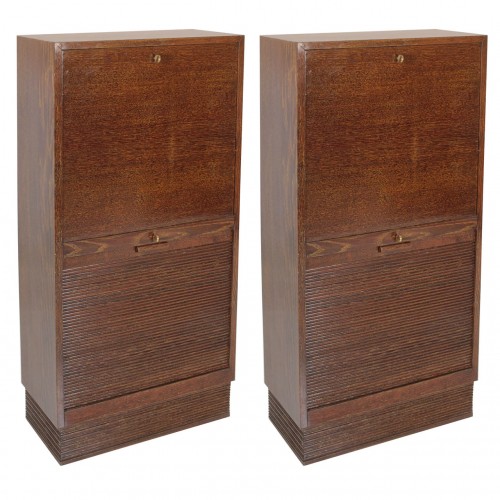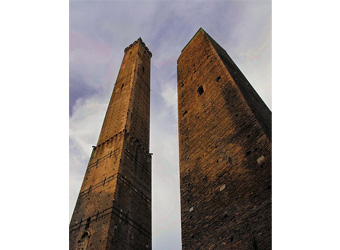Product Description
Pierre-Emile Legrain (attr.) Pair of French Art Deco drop and roll front cabinets c. 1927



PIERRE-EMILE LEGRAIN attr. (1889-1929) France
Matching Cabinets (pair) c. 1927
Golden cerused oak, roll-front and drop front doors,
original brass keys, reeded base
Provenance: Felix Marcilhac, Paris
For more information on Legrain see: Pierre-Emile Legrain 1889-1929 (Paris: exh. cat. Galerie Jacques de Vos,1996); Union des Artistes Modernes, Arlette Barré-Despond (Paris: Editions du Regard, 1986) 119-120.
H: 50 1/2 ” x W: 23 1/2” x D: 11 1/2”
The Art Deco movement centered in early 20th-century Paris sought to bridge the transition from academic art and craftsmanship to modern art and industrial production. Regarded by some as one of its founders, Pierre-Emile Legrain (1889-1929) worked at a time of great ferment in art, as well as in society. Legrain’s curiosity and receptiveness to these changes led him to adapt forms, materials and techniques from other cultures.
Legrain created two distinct bodies of work: an assemblage of approximately 1,200 bookbinding designs and a much smaller production of furniture made for couturiers in the French fashion trade. Both artistic endeavors shared fine craftsmanship, masterful use of rare and expensive materials, unusual combinations of textures and surfaces, and spare, geometrical forms. Nearly all of his creations were one-of-a-kind.
Pierre-Emile Legrain (attr.) Pair of French Art Deco drop and roll front cabinets c. 1927
G.T. Marsh was established in 1876 in San Francisco, CA as one of the first purveyors of Japanese art and antiques. In the early 30’s Marsh, with the help of his Italian bench jeweler settled on a unique style that will always be indicative of the firm. Instead of using gold or platinum, the jeweler, who was interested in gun-smithing, created a line of jewels using sandblasted steel finished with gun bluing. This resulted in a rich dark mat black finish. Chased or milegrained white gold or platinum offset pearls, jade or diamonds set against the black ground of the steel. Movement also played a part in the design. Hinged pearls or gemstones added yet another distinct element to the work or exceptionally strong contrasting graphics. The use of diamonds on a grander scale with the dramatic outline of a classic paisley form, places this brooch mid-century and at a time when Marsh’s Jewelry boutique was particularly flourishing in the Bay area.
ERIK SAXON (b. 1941) San Francisco, CA
Untitled 1975
Acrylic on canvas
Signed: Erik Saxon 74 75 (on back of frame)
Canvas H: 24” x W: 24”
Framed H: 26 1/4” x W: 26 1/4”
***24 layers of paint were applied to the surface and the painting is 24 inches high and wide. Erik Saxon was born in San Francisco in 1941 and now resides in New York City. He received both his Bachelor and Master of Arts from Berkeley (The University of California). Originally from San Francisco but based in NYC since 1968, Saxon was a core member of the Radical Painting Group active in NYC during the 1970s and 1980s. The RPG stressed a return to the core concerns of painting, focusing primarily on the monochrome. The group included Erik Saxon, Phil Sims, Merrill Wagner, Dale Henry, Doug Sanderson, Susanna Tanger, Anders Knutsson, Marcia Hafif, Jerry Zeniuk, Frederic Matys Thursz. In 1973 Saxon began making abstract work based on the grid format, initially using watercolor on paper and then industrial paint on raw canvas. The same year he began exploring the idea of monochromatic canvases – a series of acrylic drawings consisting of white and off-white squares arranged into groups of three to five panels – but tabled the idea a year later to focus his attention on paintings organized around a nine square grid structure. For the past thirty years, Saxon has worked with the monochrome and it’s relationship to its surroundings–the wall, the floor, its location within the exhibition space, and the viewer. In addition to his studio work, Saxon is a writer and has had his essays published in Artforum, Art in America, Appearances and other respectable art magazines. Radical Painting denotes an abstract art tendency in Europe and North America, which was in existence in the 1980s and 1990s and has to be seen in the light of Postmodernism. The term Radical Painting was used in the context of an exhibition at the Williams College Museum of Art in Williamstown (MA) in 1984 for the first time. It describes a self-referential art, which addresses topics of its immanent characteristics – especially color, but also image carriers, surface and structure. The Radical Painting artists and their monochrome painting are in the tradition of Post Painterly Abstraction of the 1950s and 1960s and shows notions of Minimal Art. The roots of radical art can also be found in the stylistic ambitions of Constructivism, Suprematism and Art Concret. In terms of style, radical painting is characterized by mostly monochrome works that focus on color effects, shading and material properties, entirely doing without external motifs. Radical Painting enables the observer to sensually experience the picture with its independently perceived color and light values, uniquely achieved by the painting technique, subtle coating methods or change of flows. Among the main artists of Radical Painting are Phil Sims, Marcia Hafif, Günter Umberg and Joseph Marioni; others radical artist are Jerry Zenuik, Andreas Exner, Frederic Matys Thursz, Rudolf De Crignis, Christiane Fuchs, Ingo Meller, Eric Saxon, Peter Tollens, Dieter Villinger, Ulrich Wellmann, Olivier Mosset and Winston Roeth.
Saxon’s works can be found in the following selected Public and Private Collections: artothek, Kolnisches Stadt Museum, Cologne, Germany. Bank of America, San Francisco. Fogg Museum, Havard University , Boston, MA Goteborg Museum of Art, Sweden Lita Hornik, New York IBM, San Jose, CA Wynn Kramarsky, New York Herbert Minkel, New York Mondriaanhuis, Museum voor Constructieve en Concrete Kunst, Amersfoort, Neatherlands. Morris and Helen Belkin Art Gallery, The University of British Columbia, Vancover,B.C., Canada Museo Cantonale d’Arte of Lugano , Switzerland Museum fur Kommunikation, Frankfurt, Germany Museum of Modern Art, Belgrade MOMA, Museum of Modern Art , New York . Gift of Wynn Kramarsky National Gallery of Art, Washington , D.C. UCLA Hammer Museum, Los Angeles , CA University of Kentucky Art Museum, Lexington, KY Yale University Art Gallery, New Haven, CT
